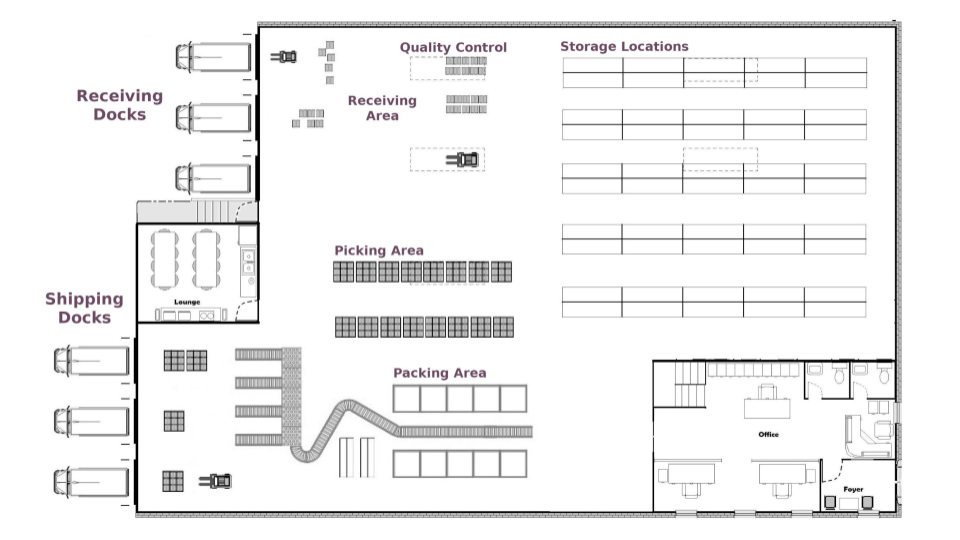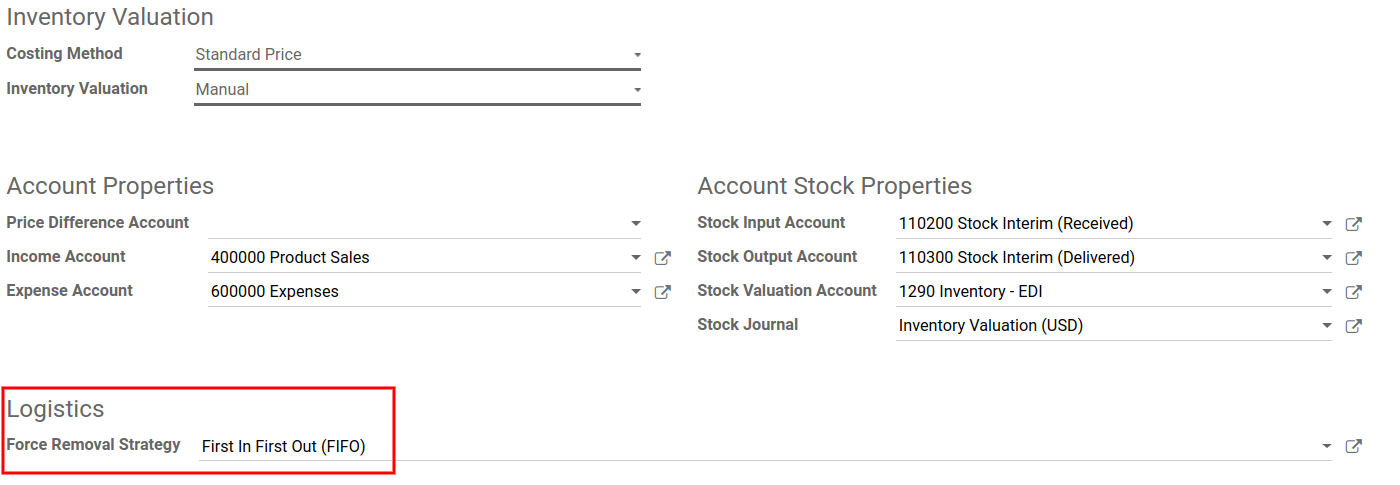What is a Removal Strategy (FIFO, LIFO, and FEFO)?¶
Usually, Removal Strategies are defined in picking operations to select the best products to optimize the distance for the worker, for quality control purposes, or to first move the products with the closest expiration date.
When a product movement needs to be done, Odoo finds available products that can be assigned to the transfer. The way Odoo assigns these products depends on the Removal Strategy defined in the Product Category or on the Location.
What happens inside the warehouse?¶
Imagine a generic warehouse plan, with receiving docks and area, storage locations, picking and packing areas, and shipping docks. All products go through all these locations, but some rules, such as removal strategies, can have an effect on which products are taken for the pickings.

Here, vendor trucks unload pallets of goods at the docks. Then, operators scan the products in the receiving area, with the receiving date and, if the product has an expiration date, the expiration date. After that, products are stored in their respective locations.

Next, several orders for the same product are made, but you didn’t receive the goods the same day and they don’t have the same expiration date. In that situation, you logically prefer sending those with the closest date first. Depending on the removal strategy you chose, Odoo generates a transfer with the products fitting your settings the best.

Примітка
On the transfer form, you can find the product’s lot/serial number to pick for delivery.
How does it work?¶
First In, First Out (FIFO)¶
When using a First In, First Out strategy, a demand for some products triggers a removal rule which requests a transfer for the lot/serial number that has entered your stock the first.
To be clearer, let’s imagine that you have three lots of nails in your warehouse. Those three have the following lot numbers: 00001, 00002, 00003, each with 5 nails boxes in it. 00001 entered the stock on the 23rd of May, 00002 on the 25th of May, and 00003 on the 1st of June. A customer orders you 6 boxes on the 11th of June. With the FIFO strategy selected, a transfer is requested for the five boxes of 00001 and one of the boxes in 00002 because 00001 has entered your stock before the others. The box from 00002 is taken because it has the oldest enter date after 00001.
So, for every order of a product with the FIFO strategy selected, Odoo requests a transfer for the good that has been in your stock for the longest period.
Last In, First Out (LIFO)¶
The same way as for FIFO, the Last In, First Out strategy is based on moving products based on the date they entered the stock. Here, a demand for some products triggers a removal rule that requests a transfer for the lot/serial number that has entered your stock the last.
To better understand, let’s imagine three lots of screws in your warehouse. Those three have the following numbers: 10001, 10002, 10003, each with 10 screw boxes in it. 10001 has entered the stock on the 1st of June, 10002 on the 3rd of June, and 10003 on the 6th of June. A customer orders 7 boxes on the 8th of June. With the LIFO strategy selected, a transfer is requested for seven boxes of 10003 because that lot is the last one to have entered the stock.
So, basically, for every order of a product with the LIFO strategy used, a transfer for the last one to have entered the stock is requested.
Примітка
This strategy is banned in many countries and can lead to only have old or obsolete products in your stock.
First Expire, First Out (FEFO)¶
The First Expire, First Out strategy is a bit different from the two others. Here, it is the expiration date that is important and not the date the product entered the stock.
Let’s imagine three lots of 6-eggs boxes (in this specific case, don’t forget to use units of measure). Those three have the following numbers: 20001, 20002, and 20003, each with 5 boxes in it. 20001 has entered the stock on the 1st of July and expires on the 15th of July, 20002 on the 2nd and expires on the 14th of July, and 20003 on the 4th and expires on the 21st of July. A customer orders 6 boxes on the 5th of July. With the FEFO strategy selected, a transfer is requested for the five boxes of 20002 and one from 20001. The transfer for all the boxes of the lot 20002 is because they have the closest expiration date. The transfer also requests one box from 20001 because it’s the lot that expires the sooner after 20002.
Then, you can remember that for every order of a product with the FEFO strategy, a transfer is requested for the product that has the nearest expiration date from the order date.
Use Removal Strategies¶
To identify some units from other ones, you need to track them, either by lot or by serial number. To do so, go to . Then, activate Storage Location, Multi-Steps Routes, and Lots & Serial Numbers.

Примітка
To work with the FEFO strategy, activate the Expiration Dates feature.
Next, you need to define your removal strategy, on Product Categories via .

FIFO (First In, First Out)¶
As said, a FIFO strategy implies that products stocked first move out first. Companies should use that method if they are selling products with short demand cycles, such as clothes, and to ensure they are not stuck with outdated styles in stock.
For this example, we created three lots of white shirts. Those are from the All/Clothes category, where we put FIFO as the removal strategy. In our stock location (WH/Stock), we now find the three lots available.

The lot 000001 contains 5 shirts, 000002 contains 3 shirts, and 000003 contains 2. As it can be seen above, 000001 has entered the stock first. Let’s create a sale order of six white shirts to check that products from that lot are the first ones to move out.
On the delivery order linked to the picking, you can see that the oldest lot numbers have been reserved thanks to the FIFO strategy.

LIFO (Last In, First Out)¶
With a LIFO strategy, that’s quite the opposite. In fact, the products that are brought the last move out the first. It is mostly used in case of products without a shelf life.
Even if our white shirts are clothes, we can say that they are timeless. So, let’s use them to test our LIFO strategy. Once again, open the product category via and change the removal strategy to LIFO.

Now, create a sale order for 4 white shirts and check that the reserved products are from lots 000003 and 000002.

Важливо
Don’t forget that the LIFO strategy is banned in many countries!
FEFO (First Expiry, First Out)¶
With the FEFO strategy, the way products are picked is not based on the reception date. In this particular case, they are dispatched according to their expiration date.
Примітка
To have more information about Expiration date, please have a look at the related doc.
By activating Expiration Dates, it becomes possible to define different dates on the serial/lot numbers to be used in FEFO. These dates can be set by going to .

Lots are picked based on their removal date, from earliest to latest. Lots without a removal date defined are picked after lots with removal dates.
Примітка
Other dates are for informational and reporting purposes only. If not removed from the stock, lots that are past the expiration dates may still be picked for delivery orders!
To use the FEFO strategy, once again go to and choose FEFO as the Force Removal Strategy.

For this particular case, let’s use hand cream. As usual, we have three lots of them.
Партія / Серійний номер |
Товар |
Термін придатності |
|---|---|---|
0000001 |
Hand Cream |
09/30/2019 |
0000002 |
Hand Cream |
11/30/2019 |
0000003 |
Hand Cream |
10/31/2019 |
When we realize a sale for 25 units of Hand Cream, we can see that the lot numbers which have been automatically reserved by Odoo are the ones with the closest expiration date, meaning 0000001 and 0000003.
